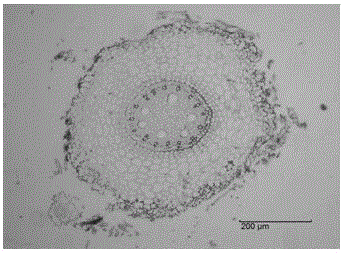A method of preparing a dactylis glomerata root tissue paraffin section
A paraffin section and root technology, which is applied in the field of paraffin section of Duck grass root tissue, can solve the problems of many chemical reagents, long production cycle and high production cost, and achieve the effects of clear cell boundaries, bright color contrast and good test effect.
- Summary
- Abstract
- Description
- Claims
- Application Information
AI Technical Summary
Problems solved by technology
Method used
Image
Examples
Embodiment 1
[0048] A preparation method for the paraffin section of the root tissue of Dactylis chinensis, according to the following steps:
[0049] (1) kill and fix
[0050] Cut the lateral root of fresh 'North Dian' Dactylis chinensis, and use a disposable double-sided blade to cut out the root tissue of Dactylis chinensis, about 2-3 mm, and immediately place it in the FAA mixed fixative for fixation, and the FAA mixed fixative Formalin, glacial acetic acid, and 70% ethanol with a volume ratio of 1:1:18; the volume of the fixative should be 10 to 15 times the total volume of the root tissue block of D. chinensis. After the material is fixed, if it is not used in time, it needs to be preserved for later use; the root tissue of the duckweed can be stored in the above-mentioned FAA mixed fixative solution and placed in the refrigerator at 4°C for half a year to one year, and the structure of the material will not change or deteriorate . The killing and fixation effectively prevent the a...
Embodiment 2-4
[0074] The first roots of ‘PI 594994’ Dactylis chinensis, the first roots of ‘PG 49’ Dactylis chinensis, and the first roots of ‘Qiancao No. 4’ Dactylis chinensis were used to make slices respectively. Others are the same as the method of embodiment 1, and the results are as follows Figure 2-4 shown. Such as image 3 Arrows: Older primary roots or visible epidermal cells keratinized, appearing as bright green "fish scales". Figure 4The lignification and suberinization of the cell walls of the outer cortical cells can be seen at the arrow, and the inner cortical cells are "horseshoe-shaped". The tissue is intact, the sections are clean, the cell boundaries are well defined, and the colors are bright and contrasting.
PUM
| Property | Measurement | Unit |
|---|---|---|
| Melting point | aaaaa | aaaaa |
| Melting point | aaaaa | aaaaa |
| Thickness | aaaaa | aaaaa |
Abstract
Description
Claims
Application Information
 Login to View More
Login to View More - R&D
- Intellectual Property
- Life Sciences
- Materials
- Tech Scout
- Unparalleled Data Quality
- Higher Quality Content
- 60% Fewer Hallucinations
Browse by: Latest US Patents, China's latest patents, Technical Efficacy Thesaurus, Application Domain, Technology Topic, Popular Technical Reports.
© 2025 PatSnap. All rights reserved.Legal|Privacy policy|Modern Slavery Act Transparency Statement|Sitemap|About US| Contact US: help@patsnap.com



